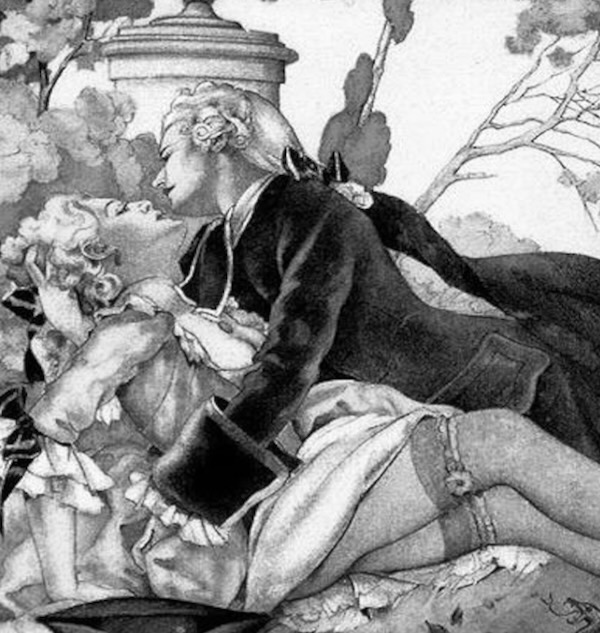
Despite doing his best work while wearing no clothes, Giacomo Casanova has been anointed a sort of patron saint of dandies. Stephen Robins, in his book “How To Be a Complete Dandy”, considers the 18th-century Venetian a dandy and invokes him as proof of the dandy’s virility. “Dandies and Don Juans,” an early 20th-century study of sportsman and adventurers by Alexander von Gleichen-Russwurm, prominently includes the adventurer and womanizer. Most importantly, our own definitive dandy genealogy chart identifies him as a precursor, albeit tangential, of the original dandy, Beau Brummell.
The chart lists Casanova as an example of the related dandy archetype of the “seductive rogue.” This archetype was linked with the dandy through the Cavaliers. Upon their return from France to the court of Charles II during the Restoration, they introduced French notions of men’s elegance into an England recovering from the Puritanism of the Puritans (who else?) and Cromwell. They also brought back a serious reputation as libertines; hence, the link between elegant attire and sexual escapades. The first serious work on dandyism, Barbey’s “Du Dandysme,” identified the Cavaliers as part of Brummell’s pedigree. The Cavaliers came into the spotlight again via the long-delayed release of Johnny Depp’s “The Libertine,” based on the life of one such Cavalier, the bisexual and scatological 17th-century English poet John Wilmot, the Earl of Rochester, arrives.
Casanova’s adoption by dandies is also probably due to some dandies’ hope for a kind of gilt by association via the rogue’s success with women. Regency dandies were noted for rakish adventures, such as Romeo Coates’ elopement with a 16-year-old Spanish (female) dancer, and a regular stop at Harriette Wilson’s bordello was part of many dandies’ social routine. Nevertheless, Bulwer-Lytton felt compelled to bowdlerize later editions of “Pelham” because certain passages were considered too effeminate and sensual. From the 1820s to 1840s the butterfly dandies, with their more colorful attire, were less distinctly masculine. Their leader, Count d’Orsay, was famous for his androgynous good looks and stands accused of bedding most of the household of Lord and Lady Blessington – teenage daughter, stepmother and father. Thus the link between the dandy and the seductive rogue became more attenuated.
Lasse Hallstrom’s “Casanova” shares the problematical dandyism of Casanova the man. If, like Baudelaire, you believe that dandyism is a protest against vulgar, bourgeois materialism, then this movie is the very thing that dandyism is protesting. If, on the other hand, you throw your lot in with Oscar, enjoy plays with an aristocratic setting, and see dandyism as a means to entertain the masses and to cultivate your own popularity, then this movie is the height of dandyism.
The film follows the established Hollywood formula. It stars Heath Ledger and Sienna Miller. Supporting actors include the dependable Oliver Platt and dandy favorite Jeremy Irons. The director is Lasse Hallstrom of such commercial hits as “Chocolat,” “The Shipping News” and “What’s Eating Gilbert Grape?” The movie uses a blue screen and very obviously — not only for action sequences, but also to recreate the architecture of 18th-century Venice. While funny, the movie depends on quips rather than wit. The plot relies on time-tested devices such as mistaken identity, mismatched lovers, and, of course, a happy ending. The chase scene near the end is unthrilling as well as unconvincing.
Heath Ledger’s Brit accent sounds exactly like George Saunders. Sienna Miller apparently is making, in her own way, an attempt at Oscar glory by forsaking glamour: She has abandoned her blonde tresses for a more studious brown. Most notable is Jeremy Irons. In his campy portrayal of an ecclesiastical inquisitor, he looks like Frankenstein’s Monster. There is something very satisfying in seeing the physical decay of someone once good-looking, who has over the years effortlessly and from a distance stolen the hearts of the ladies you have been ardently pursuing. Age is the great leveler. The pretty boys either lose their looks or start looking bizarre.
A notable exception is Sean Connery, but then again, you always knew you’d never measure up to Sean Connery. — NICK WILLARD


Even the most magnificent specimens of humanity succumb to the ravages of age. Jane Welsh Carlyle, wife of historian Thomas Carlyle, noted that the Count d’Orsay bowed to the passage of time in his toned-downed colours of the 1840s, no longer favouring “hummingbird” tones; she noted his “enlarged figure” and “worn complexion.” That said, the image of the 50-year-old Count, pot-bellied (having lost his hourglass figure), wearing baggy trousers and working on his art is a lesson to us all that time is indeed the great leveler.